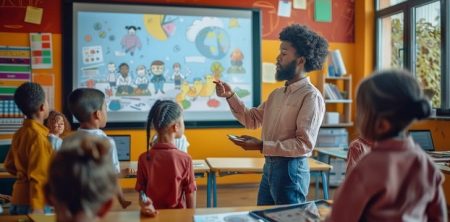The modern teacher faces unprecedented opportunities to transform STEM education through creative instructional approaches. Among the most powerful tools in this educational revolution are high-quality kids animated shows designed specifically to make science, technology, engineering, and mathematics concepts accessible and exciting for young learners. This strategic partnership between education and entertainment addresses a critical challenge: nurturing early interest in STEM fields when children are forming lifelong attitudes toward these subjects.
Research consistently demonstrates that early exposure to engaging STEM content correlates with increased interest and confidence in these subjects later in life. Animated shows designed with scientific accuracy and age-appropriate complexity provide a perfect entry point, presenting fundamental concepts through storytelling rather than abstract instruction. Teachers who incorporate these resources create classroom environments where science becomes an adventure rather than an intimidating subject.
The power of animated STEM content lies in its ability to visualize microscopic processes, theoretical concepts, and complex systems that would otherwise remain abstract to young minds. When children witness animated representations of electricity flowing through circuits, cellular processes, or mathematical relationships, these invisible phenomena become concrete and comprehensible. This visualization addresses a fundamental challenge in STEM education—helping learners grasp concepts that exist beyond direct sensory experience.
Progressive educators recognize that effective STEM learning extends beyond memorizing facts to understanding systems thinking, developing curiosity, and building problem-solving strategies. Well-designed animated shows model these approaches through characters who demonstrate scientific thinking—forming hypotheses, testing ideas through experimentation, analyzing results, and revising conclusions based on evidence. When teachers highlight these thinking patterns during viewing experiences, they reinforce the cognitive habits that underpin scientific literacy.
The characters featured in STEM-focused animation serve as powerful role models for diverse groups of students. Programs that feature female scientists, scientists of color, and characters with different abilities help dismantle stereotypes about who belongs in STEM fields. Teachers who draw attention to this representation help create more inclusive learning environments where all students can envision themselves as future scientists, engineers, or mathematicians.
Beyond the viewing experience itself, innovative teachers extend learning through hands-on activities inspired by animated content. When students conduct experiments similar to those they’ve witnessed their favorite characters perform, they experience firsthand how scientific principles operate in the physical world. This connection between screen and reality creates multidimensional learning experiences that accommodate different learning styles while reinforcing key concepts.
The episodic structure of animated series provides natural opportunities for spaced learning—an evidence-based approach that enhances long-term retention. Teachers who revisit related episodes throughout the school year create multiple exposures to core concepts, allowing students to build increasingly sophisticated understanding over time. This progressive approach respects the developmental nature of learning while maintaining engagement through beloved characters and evolving storylines.
Scientific vocabulary development represents another significant benefit of quality STEM animation. When technical terms are introduced naturally within engaging narratives, children absorb specialized language without the resistance sometimes encountered in traditional instruction. Teachers who pause to highlight and discuss new terminology help students build the academic vocabulary essential for advanced learning while maintaining the narrative flow that keeps children invested in content.
Parent partnerships flourish when teachers communicate about the animated STEM content being used in classrooms. By sharing episode information and suggesting follow-up conversations or activities families can implement at home, educators extend learning beyond school hours. This coordination creates powerful continuity that reinforces concepts while demonstrating to children that science exists everywhere, not just within classroom walls.
Some critics express concern that animation might oversimplify complex scientific concepts, but research indicates that age-appropriate simplification actually enhances understanding by providing accessible entry points to advanced topics. Skilled teachers address this concern by acknowledging when concepts have been simplified for younger audiences and providing pathways toward more nuanced understanding as students develop readiness for greater complexity.
The technological environments that today’s students will navigate throughout their lives demand unprecedented levels of scientific literacy and technical understanding. By integrating engaging animated content into comprehensive STEM education approaches, forward-thinking teachers prepare children for these future challenges. This preparation extends beyond specific content knowledge to developing the curiosity, critical thinking, and information literacy skills essential for lifelong learning in rapidly evolving fields.
As educational technology continues advancing, the relationship between teachers, students, and animated STEM content grows increasingly interactive. Augmented reality extensions of popular animated shows now allow children to manipulate virtual models, conduct simulated experiments, and explore scientific phenomena through immersive experiences. Teachers who incorporate these technologies create classroom environments that blend entertainment, education, and innovation in ways previous generations could scarcely imagine.
The most effective STEM educators recognize that animated content serves as a beginning rather than an end—a spark that ignites curiosity leading to deeper exploration. By creating learning pathways that begin with engaging animated introductions and progress toward increasingly sophisticated understanding, teachers leverage children’s natural affinity for animation while guiding them toward genuine scientific literacy.

